Convert HTML to PDF file in Azure using C#
20 Jan 202520 minutes to read
The Syncfusion® HTML to PDF converter is a .NET library for converting webpages, SVG, MHTML, and HTML to PDF using C#. It is reliable and accurate. The result preserves all graphics, images, text, fonts, and the layout of the original HTML document or webpage. Using this library, you can convert an HTML to PDF using C# with the Blink rendering engine in Azure App Service on Linux, Azure app service using the Linux docker container and Azure Function Application Linux.
NOTE
HTML to PDF converter is not supported with Azure App Service windows. We internally use Blink rendering engine for the conversion, it uses GDI calls for viewing and rendering the webpages. But Azure app service blocks GDI calls in the Azure website environment. As the Azure website does not have the elevated permission and enough rights, we can not launch the Chrome headless browser in the Azure app service windows (Azure website and Azure function).
Azure App Service Linux
Steps to convert HTML to PDF in Azure App service on Linux
Step 1: Create a new ASP.NET Core MVC application.

Step 2: Choose your project’s target framework and select Configure for HTTPS.
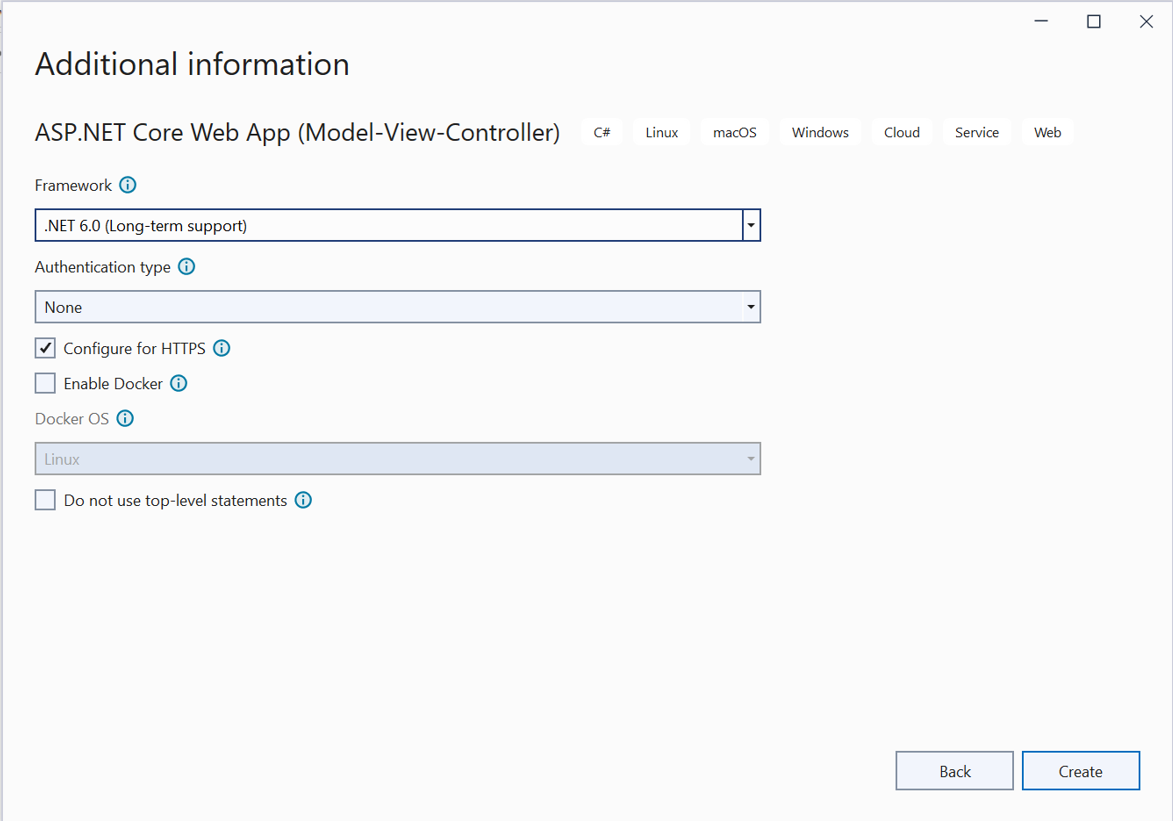
Step 3: Install the Syncfusion.HtmlToPdfConverter.Net.Linux NuGet package as a reference to your .NET Core application NuGet.org.
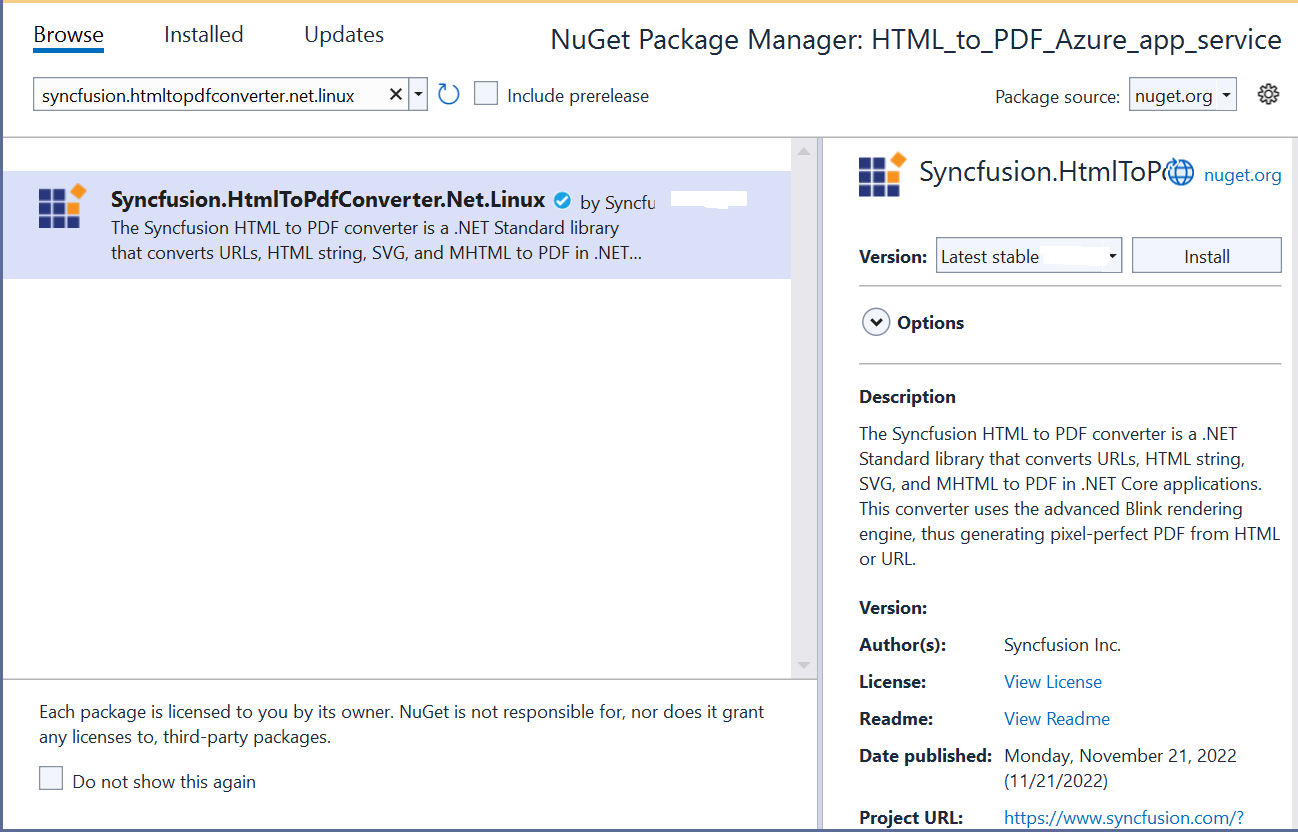
NOTE
Starting with v16.2.0.x, if you reference Syncfusion® assemblies from trial setup or from the NuGet feed, you also have to add “Syncfusion.Licensing” assembly reference and include a license key in your projects. Please refer to this link to know about registering Syncfusion® license key in your application to use our components.
There are two ways to install the dependency packages to Azure server,
- Using SSH from Azure portal.
- By running the commands from C#.
Using SSH command line
-
After publishing the Web application, login to the Azure portal in a web interface and open the published app service. Under Development Tools Menu, Open the SSH and Click the go link.
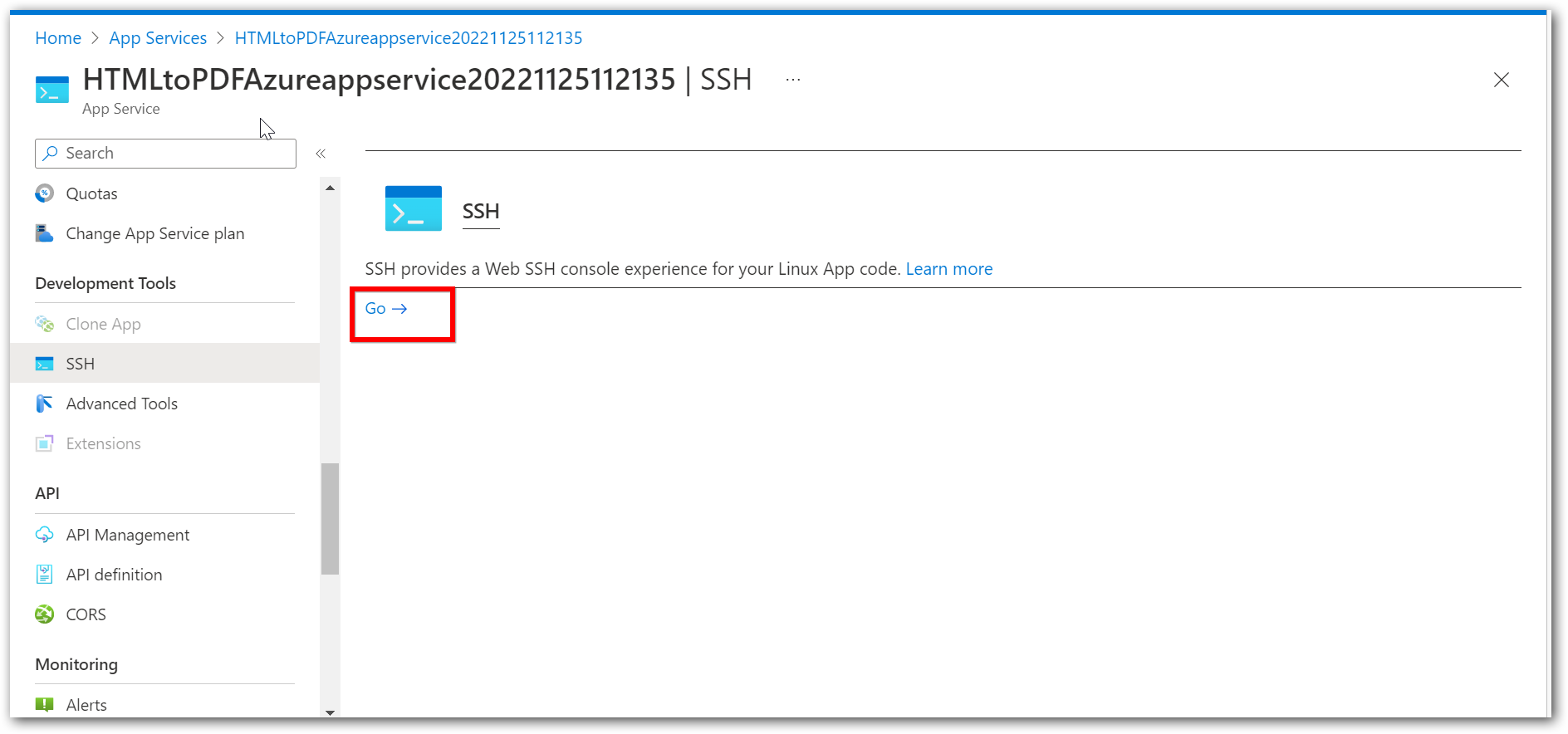
-
From the terminal window, you can install the dependency packages. Use the following single command to install all dependencies packages.
apt-get update && apt-get install -yq --no-install-recommends libasound2 libatk1.0-0 libc6 libcairo2 libcups2 libdbus-1-3 libexpat1 libfontconfig1 libgcc1 libgconf-2-4 libgdk-pixbuf2.0-0 libglib2.0-0 libgtk-3-0 libnspr4 libpango-1.0-0 libpangocairo-1.0-0 libstdc++6 libx11-6 libx11-xcb1 libxcb1 libxcursor1 libxdamage1 libxext6 libxfixes3 libxi6 libxrandr2 libxrender1 libxss1 libxtst6 libnss3 libgbm1Running the commands from C#
-
Create a shell file with the above commands in the project and name it as dependenciesInstall.sh. In this article, these steps have been followed to install dependencies packages.
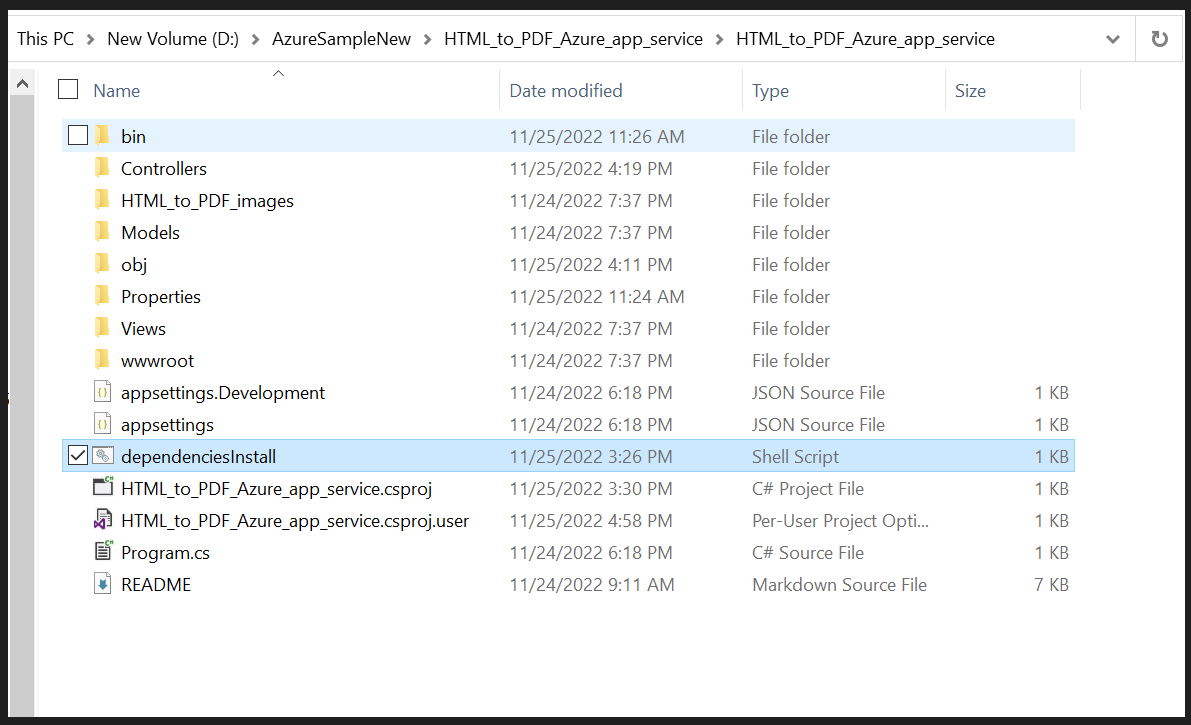
-
Set Copy to Output Directory as “Copy if newer” to the dependenciesInstall.sh file.
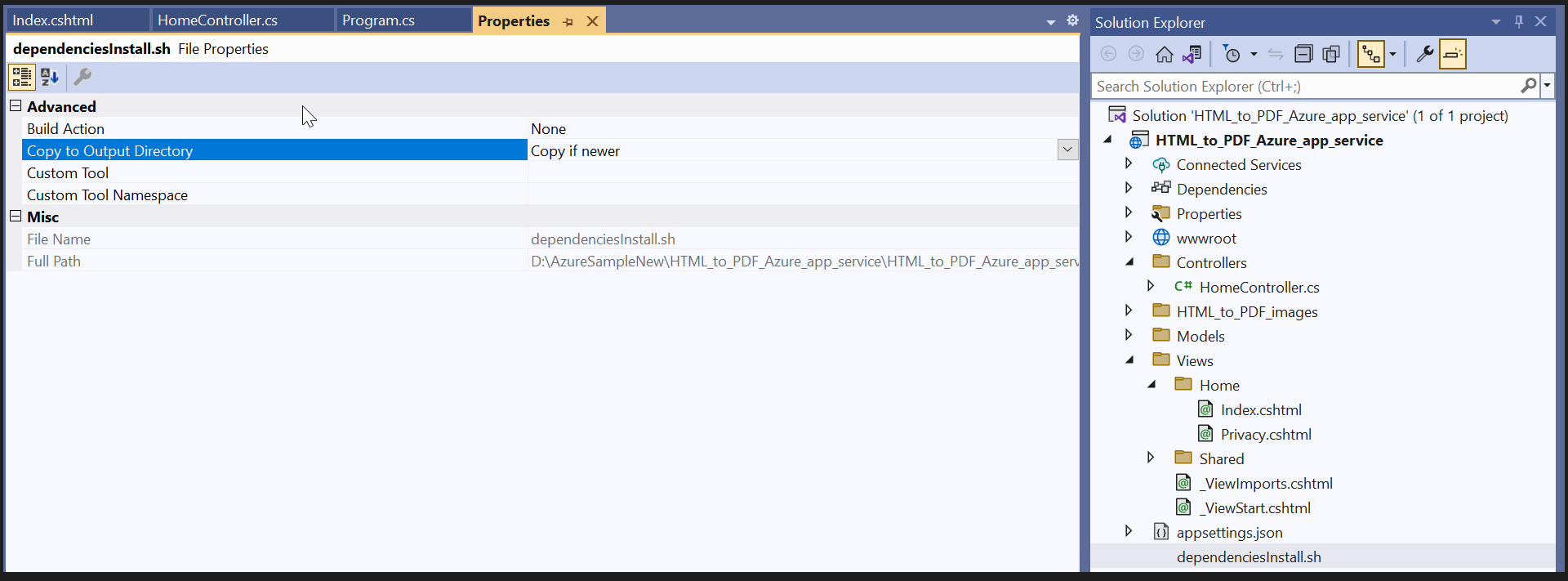
Step 4: Add an Export to the PDF button in the index.cshtml.
<div class="btn">
@{ Html.BeginForm("ExportToPDF", "Home", FormMethod.Post);
{
<input type="submit" value="Export To PDF" class=" btn" />
}
}
</div>Step 5: Include the following namespaces.
using Syncfusion.HtmlConverter;
using Syncfusion.Pdf;
using System.IO;Step 6: Add the code samples in the controller to convert HTML to PDF document using Convert method in HtmlToPdfConverter class. The Blink command line arguments based on the given CommandLineArguments property of BlinkConverterSettings class. .
public ActionResult ExportToPDF()
{
Environment.SetEnvironmentVariable("ASPNETCORE_ENVIRONMENT", "Development");
//Install the dependencies packages for HTML to PDF conversion in Linux
string shellFilePath = System.IO.Path.Combine(env.ContentRootPath, "dependenciesInstall.sh");
InstallDependecies(shellFilePath);
//Initialize HTML to PDF converter
HtmlToPdfConverter htmlConverter = new HtmlToPdfConverter();
BlinkConverterSettings settings = new BlinkConverterSettings();
//Set command line arguments to run without sandbox.
settings.CommandLineArguments.Add("--no-sandbox");
settings.CommandLineArguments.Add("--disable-setuid-sandbox");
//Assign BlinkConverter settings to the HTML converter
htmlConverter.ConverterSettings = settings;
//Convert HTML string to PDF
PdfDocument document = htmlConverter.Convert("http://www.syncfusion.com");
//Save the document into stream
MemoryStream stream = new MemoryStream();
document.Save(stream);
stream.Position = 0;
//Close the document
document.Close(true);
//Defining the ContentType for pdf file
string contentType = "application/pdf";
//Define the file name
string fileName = "URL_to_PDF.pdf";
//Creates a FileContentResult object by using the file contents, content type, and file name
return File(stream, contentType, fileName);
}
private void InstallDependecies(string shellFilePath)
{
Process process = new Process
{
StartInfo = new ProcessStartInfo
{
FileName = "/bin/bash",
Arguments = "-c " + shellFilePath,
CreateNoWindow = true,
UseShellExecute = false,
}
};
process.Start();
process.WaitForExit();
}Steps to publish as Azure App Linux
Step 1: Right-click the project and select Publish.
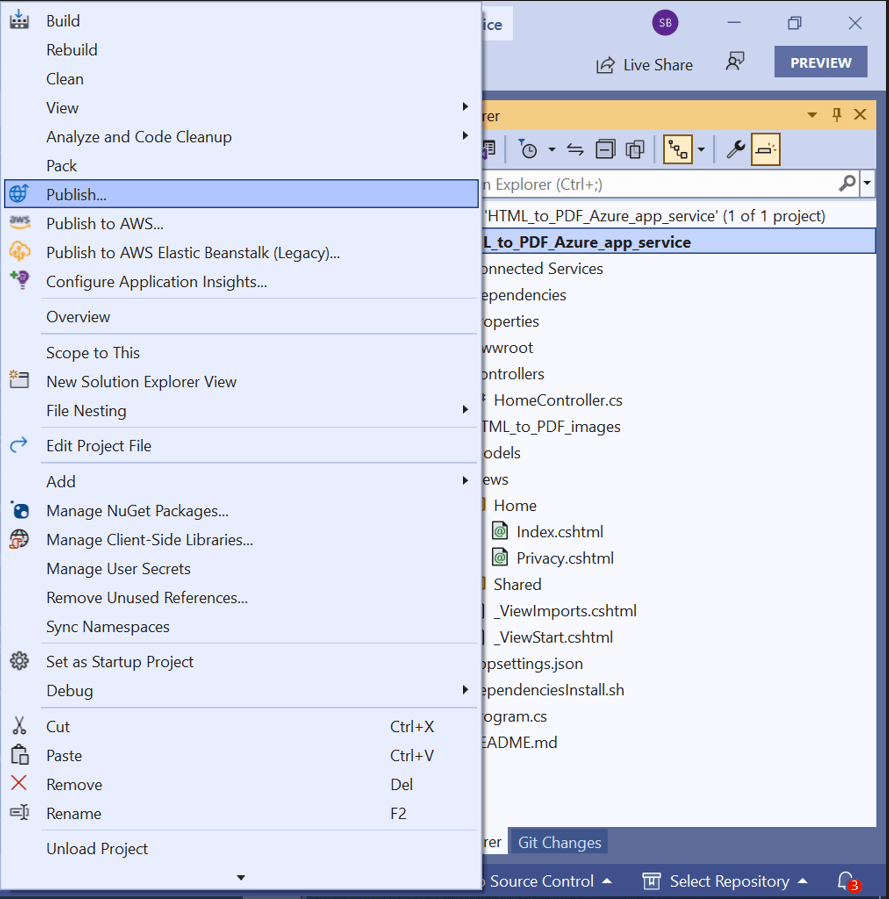
Step 2: Create a new profile in publish target window.
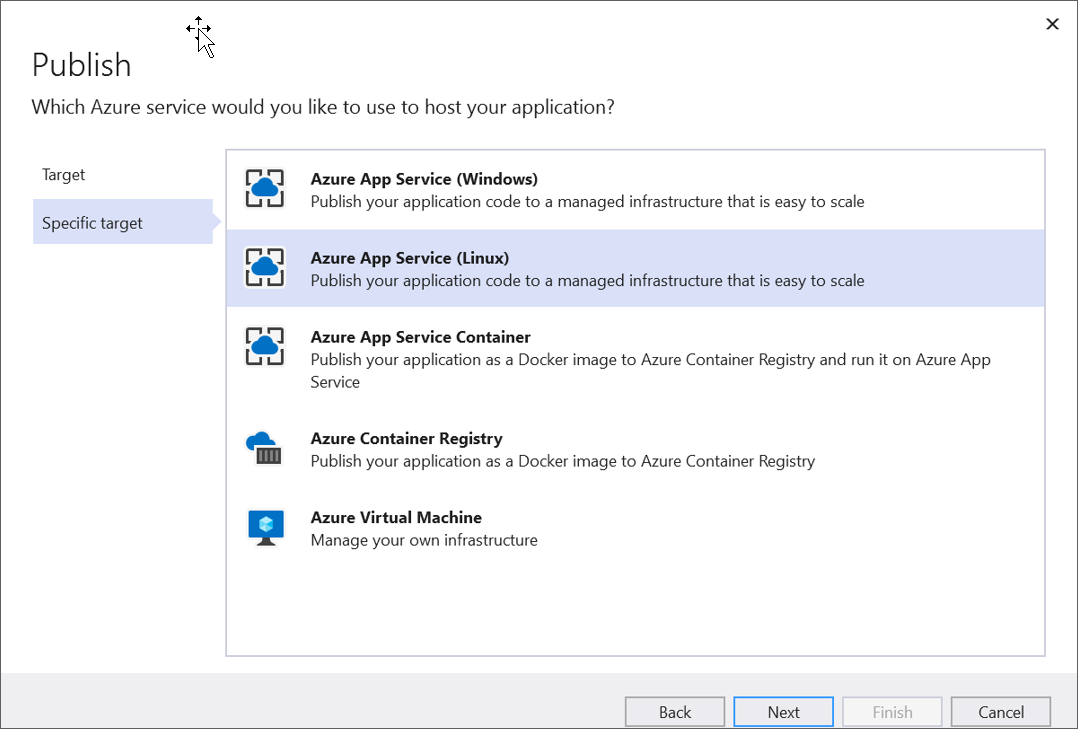
Step 3: Create App service using Azure subscription and select a hosting plan.

Step 4: HTML to PDF conversion works from basic hosting plan (B1 to P3). So, select the hosting plan as required. HTML to PDF conversion will not work if the hosting plan is Free/Shared.
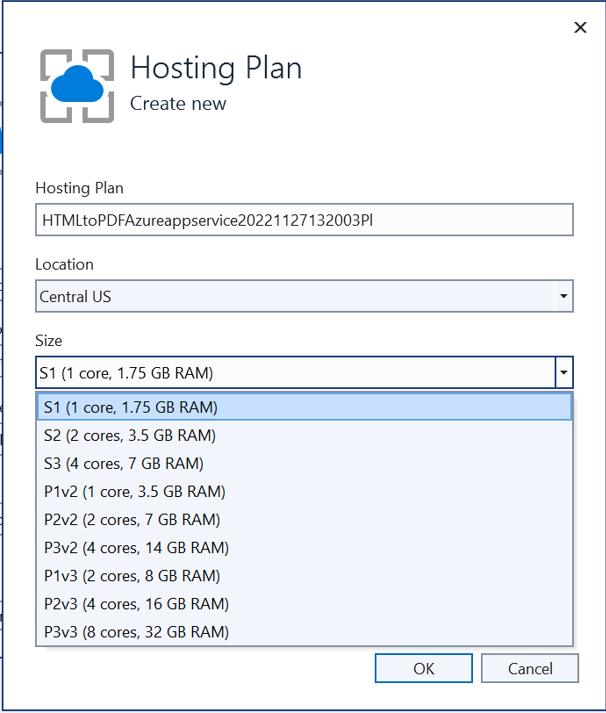
Step 5: After creating a profile, click the publish button.
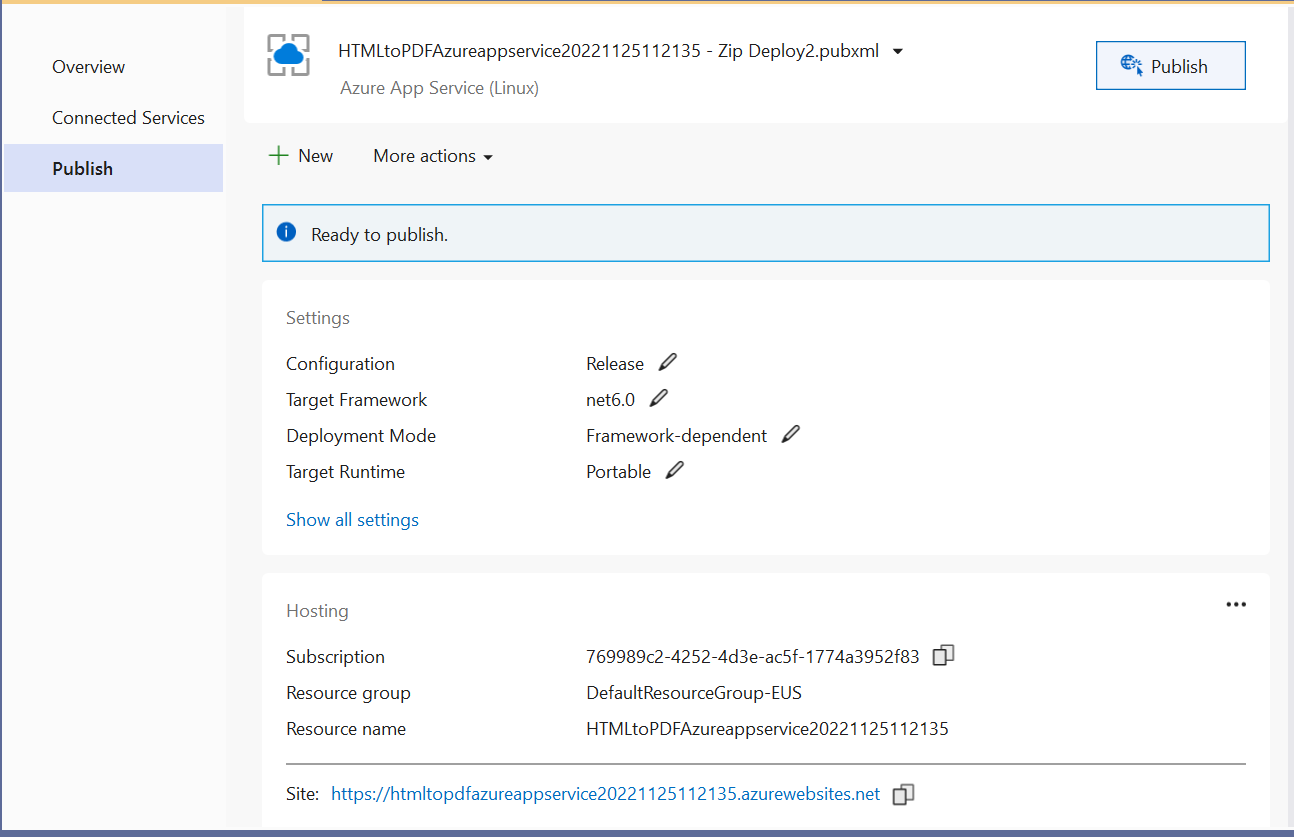
Now, the published webpage will open in the browser. Click Export to PDF button to convert Syncfusion® webpage to PDF document.
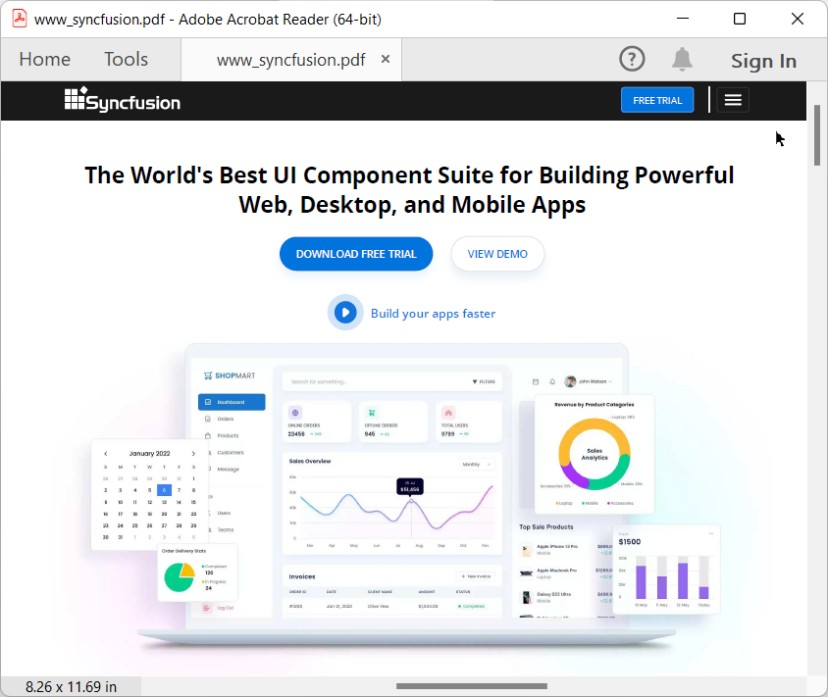
A complete work sample for converting an HTML to PDF in Azure App service on Linux can be downloaded from GitHub.
Azure App Service Linux with docker
Steps to convert HTML to PDF in Azure app service using Blink with Linux docker container
Step 1: Create a new ASP.NET Core application and enable the docker support with Linux as a target OS.

Step 2: Choose your project’s target framework, select Configure for HTTPS and Enable Docker.

Step 3: Install the Syncfusion.HtmlToPdfConverter.Net.Linux NuGet package as a reference to your .NET Core application NuGet.org.
NOTE
Starting with v16.2.0.x, if you reference Syncfusion® assemblies from trial setup or from the NuGet feed, you also have to add “Syncfusion.Licensing” assembly reference and include a license key in your projects. Please refer to this link to know about registering Syncfusion® license key in your application to use our components.
Step 4: Include the following commands in the docker file to install the dependent packages in the docker container.
RUN apt-get update && \
apt-get install -yq --no-install-recommends \
libasound2 libatk1.0-0 libc6 libcairo2 libcups2 libdbus-1-3 \
libexpat1 libfontconfig1 libgcc1 libgconf-2-4 libgdk-pixbuf2.0-0 libglib2.0-0 libgtk-3-0 libnspr4 \
libpango-1.0-0 libpangocairo-1.0-0 libstdc++6 libx11-6 libx11-xcb1 libxcb1 \
libxcursor1 libxdamage1 libxext6 libxfixes3 libxi6 libxrandr2 libxrender1 libxss1 libxtst6 \
libnss3 libgbm1
Step 5: Add a new button in the Index.cshtml file.
<div class="btn">
@{ Html.BeginForm("ExportToPDF", "Home", FormMethod.Post);
{
<input type="submit" value="Export To PDF" class=" btn" />
}
}
</div>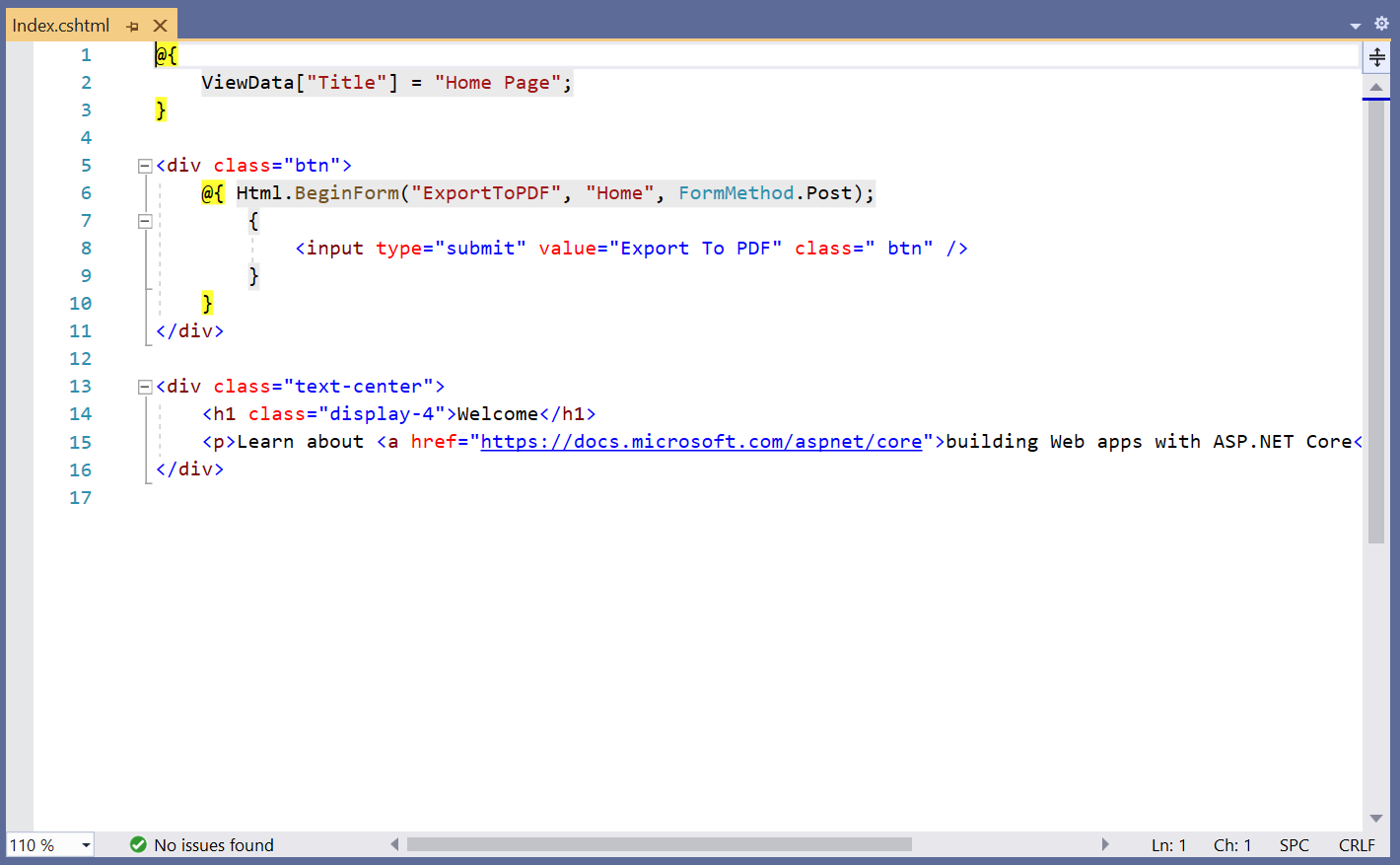
Step 6: Include the following namespaces.
using Syncfusion.HtmlConverter;
using Syncfusion.Pdf;
using System.IO;Step 7: Add the code samples in the controller to convert HTML to PDF document using Convert method in HtmlToPdfConverter class. The Blink command line arguments based on the given CommandLineArguments property of BlinkConverterSettings class.
public ActionResult ExportToPDF()
{
//Initialize HTML to PDF converter.
HtmlToPdfConverter htmlConverter = new HtmlToPdfConverter();
BlinkConverterSettings settings = new BlinkConverterSettings();
//Set command line arguments to run without the sandbox.
settings.CommandLineArguments.Add("--no-sandbox");
settings.CommandLineArguments.Add("--disable-setuid-sandbox");
//Assign Blink settings to the HTML converter.
htmlConverter.ConverterSettings = settings;
//Convert URL to PDF.
PdfDocument document = htmlConverter.Convert("https://www.syncfusion.com");
MemoryStream stream = new MemoryStream();
//Save and close a PDF document.
document.Save(stream);
return File(stream.ToArray(), System.Net.Mime.MediaTypeNames.Application.Pdf, "URL_to_PDF.pdf");
}Step 8: Build and run the sample in docker, it will pull the Linux docker image from the docker hub and run the project. Now, the webpage will open in the browser and click the button to convert the Syncfusion® webpage to a PDF.
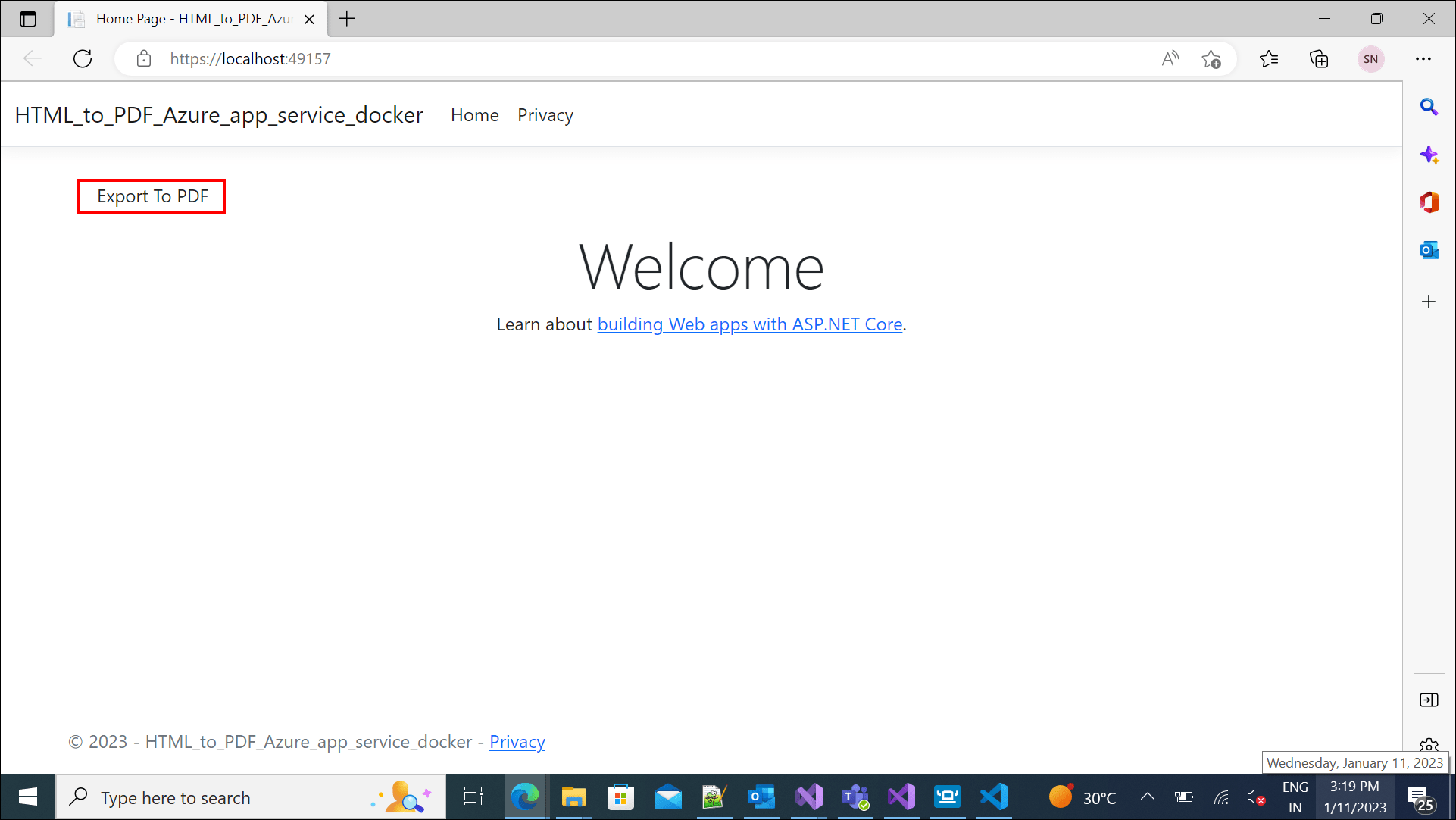
By executing the program, you will get the PDF document as follows.

Deploy the container to Azure container instance
Step 1: Create a publish target to deploy the docker image to Azure.
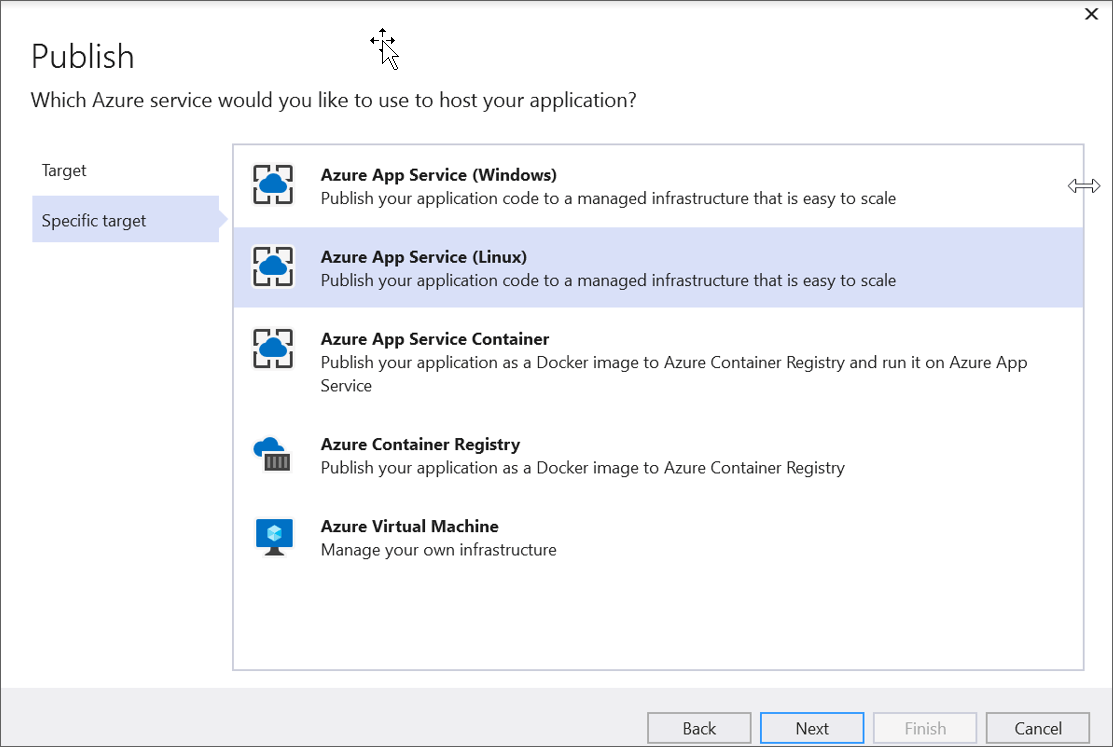
Step 2: Create Azure App Service with resource group, hosting plan, and container registry.
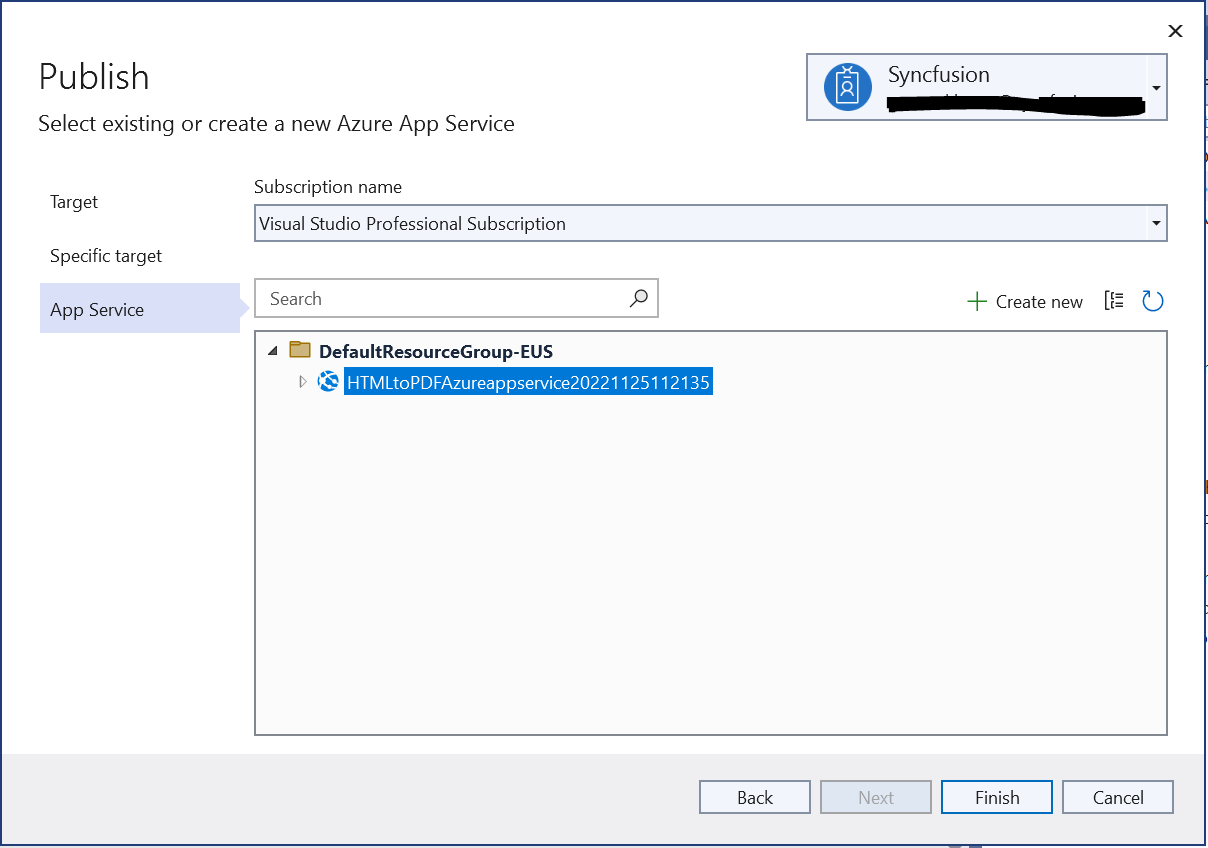
Step 3: Publish the docker image to Azure container instance.

Step 4: It will push the docker image to the Azure container registry and deploy it to the Azure container instance.
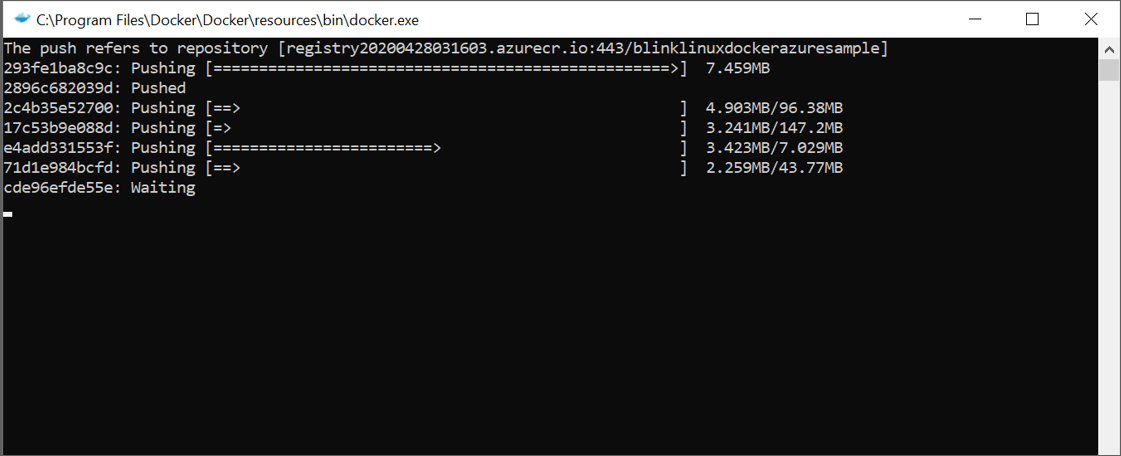
Step 5: After successful deployment, it will open the Azure website in the browser.

Step 6: Click the button to convert Syncfusion® webpage to a PDF document. You will get the PDF document as follows.

A complete work sample can be downloaded from Github
Azure App Function Linux
Steps to convert HTML to PDF in the Azure Functions using the Blink rendering engine
Step 1: Create the Azure function project.
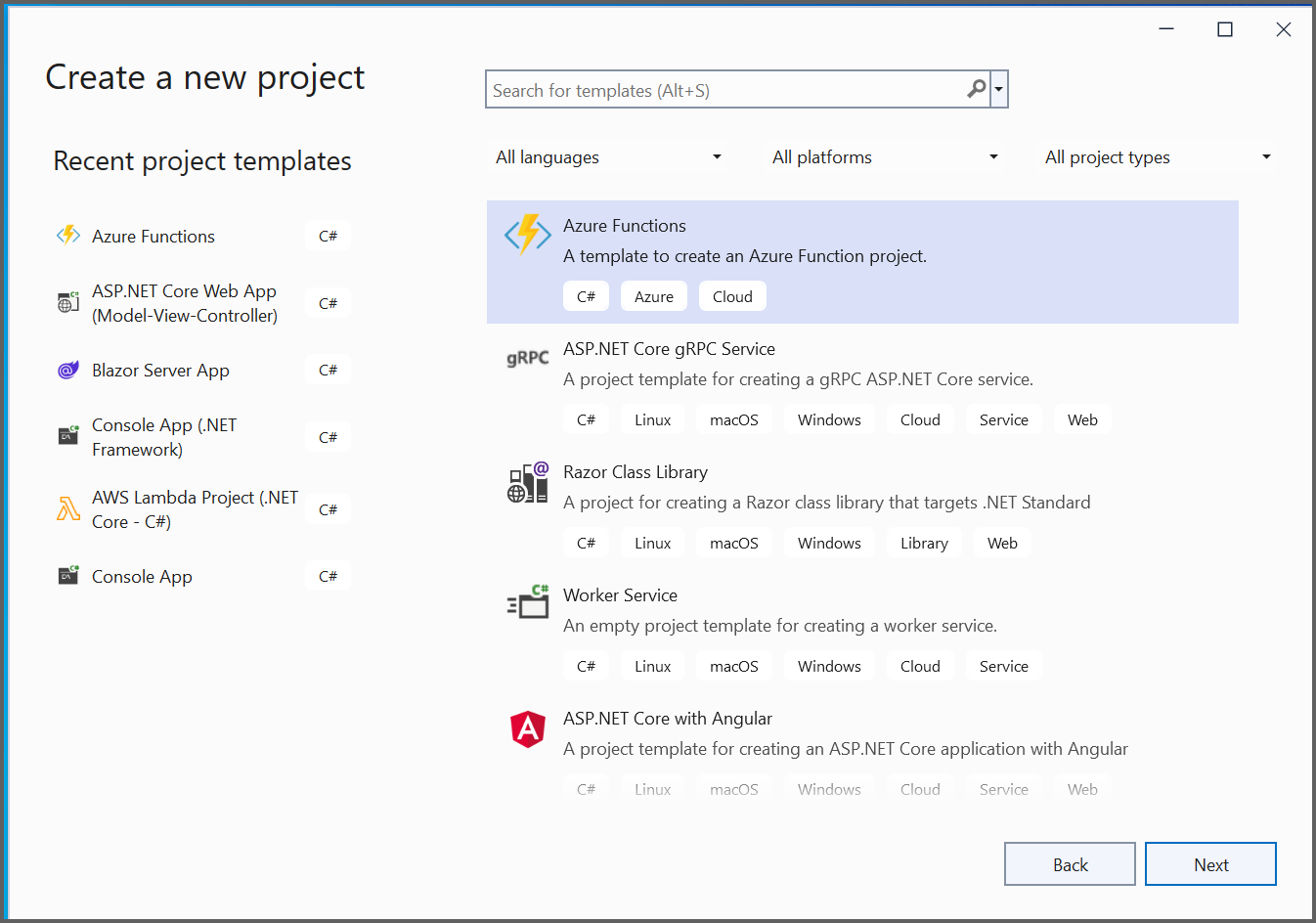
Step 2: Select the Azure Functions type and .NET Core version.
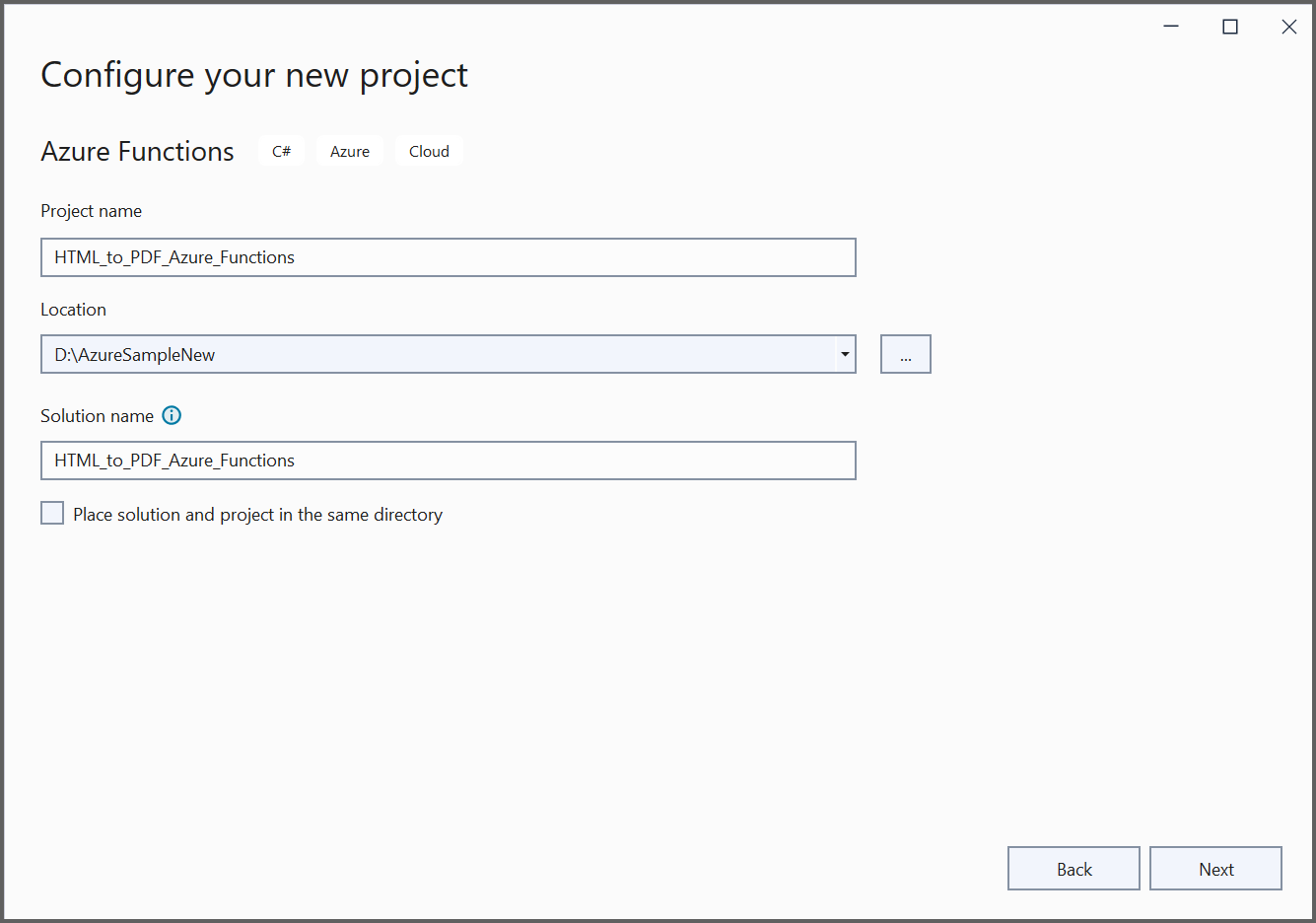
Step 3: Install the Syncfusion.HtmlToPdfConverter.Net.Linux NuGet package as a reference to your .NET Core application NuGet.org.

NOTE
Starting with v16.2.0.x, if you reference Syncfusion® assemblies from trial setup or from the NuGet feed, you also have to add “Syncfusion.Licensing” assembly reference and include a license key in your projects. Please refer to this link to know about registering Syncfusion® license key in your application to use our components.
Step 4: Include the following namespaces in Function1.cs file.
using Syncfusion.HtmlConverter;
using Syncfusion.Pdf;
using System.Runtime.InteropServices;Step 5: Add the following code example in the Function1 class to convert HTML to PDF document using Convert method in HtmlToPdfConverter class. The Blink command line arguments based on the given CommandLineArguments property of BlinkConverterSettings class.
[FunctionName("Function1")]
public static async Task<IActionResult> Run([HttpTrigger(AuthorizationLevel.Function, "get", "post", Route = null)] HttpRequest req, ILogger log, ExecutionContext executionContext)
{
string blinkBinariesPath = string.Empty;
try
{
blinkBinariesPath = SetupBlinkBinaries(executionContext);
}
catch
{
throw new Exception("BlinkBinaries initialization failed");
}
string url = req.Query["url"];
//Initialize the HTML to PDF converter with the Blink rendering engine.
HtmlToPdfConverter htmlConverter = new HtmlToPdfConverter(HtmlRenderingEngine.Blink);
BlinkConverterSettings settings = new BlinkConverterSettings();
//Set command line arguments to run without sandbox.
settings.CommandLineArguments.Add("--no-sandbox");
settings.CommandLineArguments.Add("--disable-setuid-sandbox");
settings.BlinkPath = blinkBinariesPath;
//Assign BlinkConverter settings to the HTML converter
htmlConverter.ConverterSettings = settings;
//Convert URL to PDF
PdfDocument document = htmlConverter.Convert(url);
MemoryStream ms = new MemoryStream();
//Save and close the PDF document
document.Save(ms);
document.Close();
ms.Position = 0;
return new FileStreamResult(ms, "application/pdf");
}Step 6: Add the following helper methods to copy and set permission to the BlinkBinariesLinux folder.
private static string SetupBlinkBinaries(ExecutionContext executionContext)
{
string blinkAppDir = Path.Combine(executionContext.FunctionAppDirectory, "BlinkBinariesLinux");
string tempBlinkDir = Path.GetTempPath();
string chromePath = Path.Combine(tempBlinkDir, "chrome");
if (!File.Exists(chromePath))
{
CopyFilesRecursively(blinkAppDir, tempBlinkDir);
SetExecutablePermission(tempBlinkDir);
}
return tempBlinkDir;
}
private static void CopyFilesRecursively(string sourcePath, string targetPath)
{
//Create all the directories from the source to the destination path.
foreach (string dirPath in Directory.GetDirectories(sourcePath, "*", SearchOption.AllDirectories))
{
Directory.CreateDirectory(dirPath.Replace(sourcePath, targetPath));
}
//Copy all the files from the source path to the destination path.
foreach (string newPath in Directory.GetFiles(sourcePath, "*.*", SearchOption.AllDirectories))
{
File.Copy(newPath, newPath.Replace(sourcePath, targetPath), true);
}
}
[DllImport("libc", SetLastError = true, EntryPoint = "chmod")]
internal static extern int Chmod(string path, FileAccessPermissions mode);
private static void SetExecutablePermission(string tempBlinkDir)
{
FileAccessPermissions ExecutableFilePermissions = FileAccessPermissions.UserRead | FileAccessPermissions.UserWrite | FileAccessPermissions.UserExecute |
FileAccessPermissions.GroupRead | FileAccessPermissions.GroupExecute | FileAccessPermissions.OtherRead | FileAccessPermissions.OtherExecute;
string[] executableFiles = new string[] { "chrome", "chrome_sandbox" };
foreach (string executable in executableFiles)
{
var execPath = Path.Combine(tempBlinkDir, executable);
if (File.Exists(execPath))
{
var code = Function1.Chmod(execPath, ExecutableFilePermissions);
if (code != 0)
{
throw new Exception("Chmod operation failed");
}
}
}
}Step 7: Include the below enum in the Function1.cs file.
[Flags]
internal enum FileAccessPermissions : uint
{
OtherExecute = 1,
OtherWrite = 2,
OtherRead = 4,
GroupExecute = 8,
GroupWrite = 16,
GroupRead = 32,
UserExecute = 64,
UserWrite = 128,
UserRead = 256
}Publish to Azure Functions Linux
Step 1: Right-click the project and select Publish. Then, create a new profile in the Publish Window. The Blink rendering engine will work in consumption plan. So, you can create the Azure Function App service with a consumption plan.
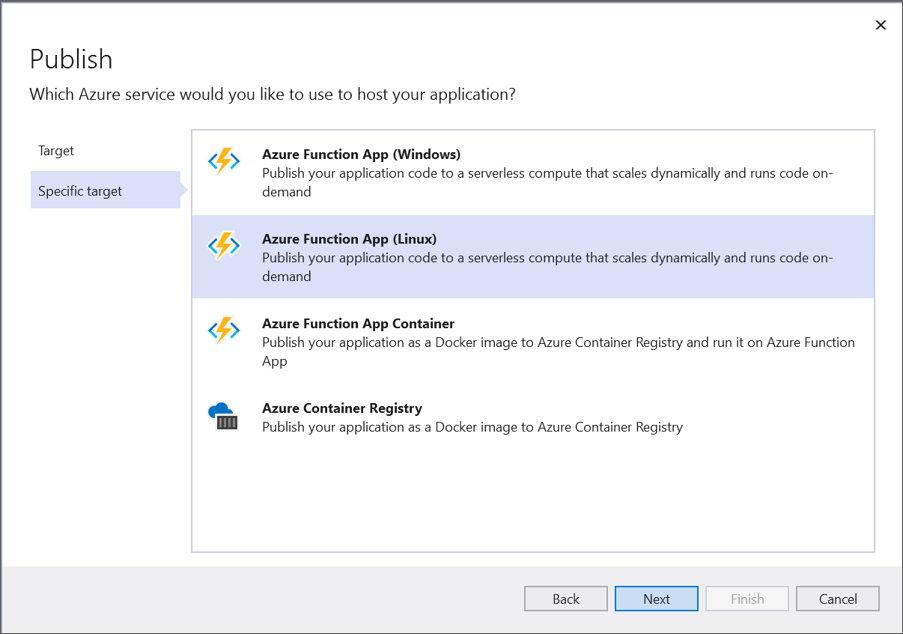
Step 2: After creating the profile, click the Publish button.
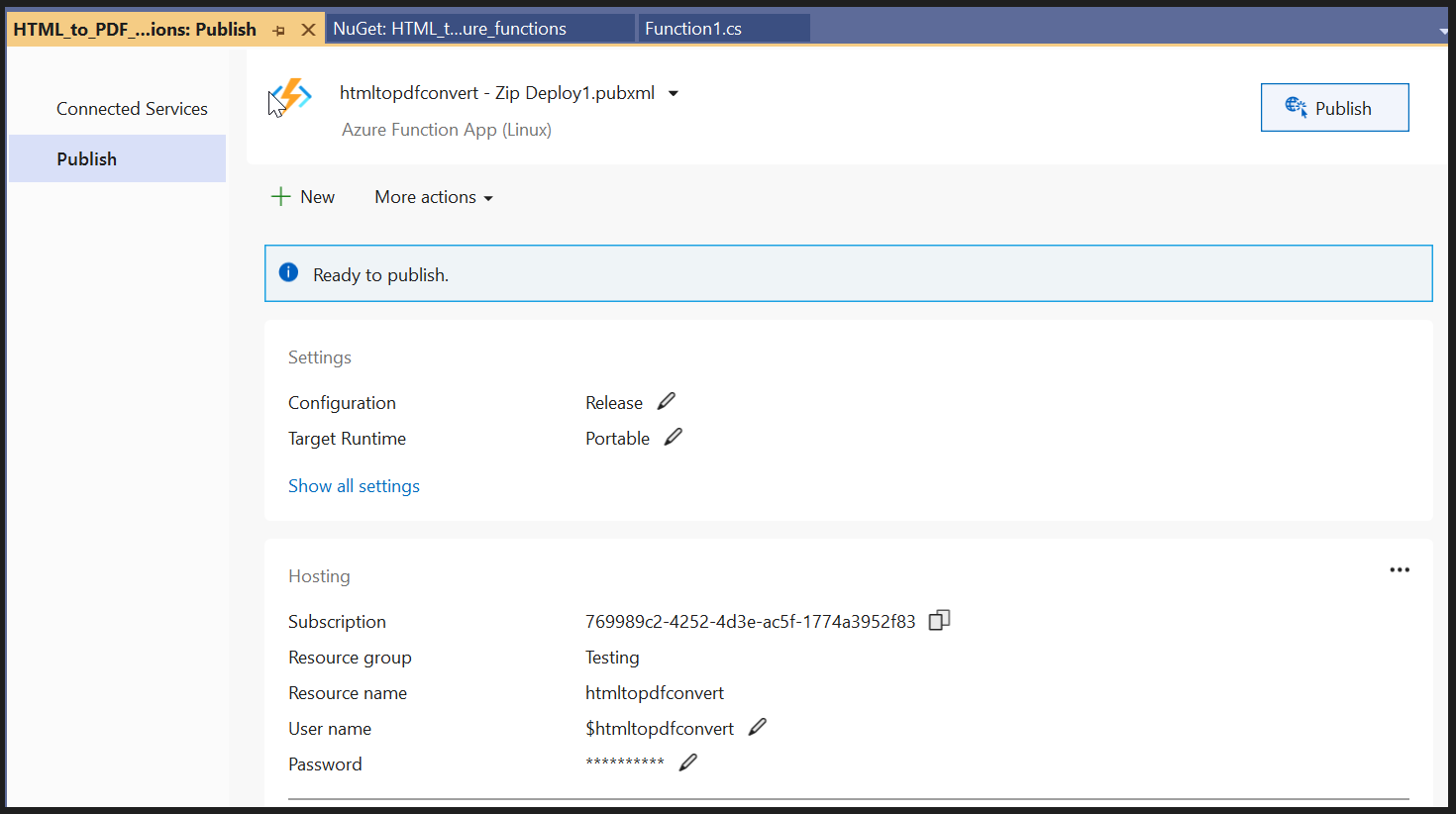
Step 3: Now, go to the Azure portal and select the App Services. After running the service, click Get function URL > Copy. Include the URL as a query string in the URL. Then, paste it into the new browser tab. You will get the PDF document as follows.

A complete working sample can be downloaded from Github
Click here to explore the rich set of Syncfusion® HTML to PDF converter library features.
An online sample link to convert HTML to PDF document in ASP.NET Core.